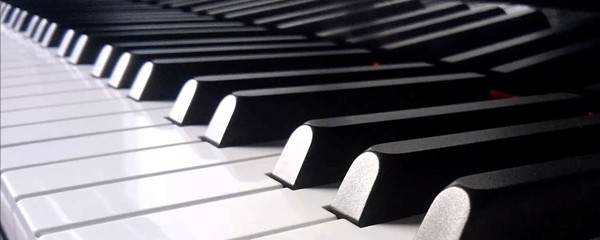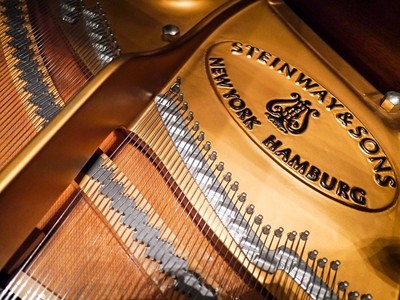
The one thing that I often hear from beginner to intermediate piano players is that the chords they play sound very plain. One of the primary reasons for such plain sounding chords is that they're often written that way in sheet music. It can be traditional sheet music or a simple lead sheet.
Major and minor triads are among the most fundamental elements of harmony, but let's face it: It's easy to get bored with just plain  sounding chords and might I add that all your songs will sound that same if you don't go beyond them.
sounding chords and might I add that all your songs will sound that same if you don't go beyond them.
In today's article, I want to break down the process of learning how to build an extended chord based on any Major or minor triad. It's much simpler than most beginners at the piano would think it is. So let me show you how easy it is to turn those basic triads into rich extended chords that will make any song that you play sound professional.
I'm going to assume that you know your Major and minor triads, but it doesn't hurt to recap even the most basic musical concepts. So here goes...
In a Major key of music you have 7 different notes.  You can build a chord off of each one of these tones. The one we want to focus on today is the tonic also known as the 1 chord. The 1 chord in any Major key of music is always Major.
You can build a chord off of each one of these tones. The one we want to focus on today is the tonic also known as the 1 chord. The 1 chord in any Major key of music is always Major. This is actually the root chord of the key. Another way to think of this chord is to look at it as the foundation chord of the key. Of course, every other Major key of music has a 1 chord also.
This is actually the root chord of the key. Another way to think of this chord is to look at it as the foundation chord of the key. Of course, every other Major key of music has a 1 chord also.
So what are extended chords and what makes them so great? Extended chords are defined as tertian chords. This means they're built or constructed in 3rd intervals. So if you take any key of music such as the ones we just covered, and play every other note, you have a chord based on thirds or tertian harmony.
Getting back to C Major as our example, let's look at what tones (or notes) that you can add to a Major triad to make it an extended chord.
What's your pleasure: 7 or flat 7?
Most of the notes that you can add to a Major chord are going to consist of those that reside within the key. This is also known as diatonic harmony. But not all of them. As I'll show you, there's a note that's not in the key that's very common to create extended chords. And this note just happens to be pretty critical to understand.
What I'm getting to are 7th chords. There's actually two different kinds of 7th chords. Don't let this confuse you. It's easy to understand because you all you have to do is listen to the difference between the two.
Notice the 7th tone in the key of C Major is B. This is the Major 7th tone.  It's easy to remember this because the Major 7th is a Major scale tone. You can create a C Major 7 chord by adding this note to the C major triad. Play this chord on your piano or keyboard. Notice that it has a consonant or smooth sound to it.
It's easy to remember this because the Major 7th is a Major scale tone. You can create a C Major 7 chord by adding this note to the C major triad. Play this chord on your piano or keyboard. Notice that it has a consonant or smooth sound to it.
 The other type of 7th chord is the dominant 7th. It consists of adding the flatted 7th to a Major triad. You simply lower the Major
The other type of 7th chord is the dominant 7th. It consists of adding the flatted 7th to a Major triad. You simply lower the Major Now play this chord on your piano or keyboard. Unlike the Major 7th, it has a dissonant or harsher sounding quality to it.
Now play this chord on your piano or keyboard. Unlike the Major 7th, it has a dissonant or harsher sounding quality to it.
7th chords, whether they're Major or dominant, are very common. They're so common in popular music that some music theorists don't regard them as extended chords. However, they are technically extended chords and should be categorized this way for beginners to understand them.
There Must Be Higher Extensions
Now that we've made the distinction between the Major 7th and the dominant 7th chords, we need to clarify extended tones so they make sense. If there are only 7 different notes in a key of music, why can extended chords include a 9th, 11th, or a 13th?
Extended tones make this possible. So how do we determine them? Every key of music has higher extensions. These are tones beyond the 7th note in the scale. If you continue to count beyond the 7 notes, you can count all the way up to 13.
 These higher extensions are not usually recognized beyond the 13th so we won't go beyond that. There's one important aspect of extended chords: They must contain either one of the 7th tones that I covered earlier. If the chord contains the Dominant 7th, it's a dominant extended chord. If it contains the major 7th, it's a Major extended chord.
These higher extensions are not usually recognized beyond the 13th so we won't go beyond that. There's one important aspect of extended chords: They must contain either one of the 7th tones that I covered earlier. If the chord contains the Dominant 7th, it's a dominant extended chord. If it contains the major 7th, it's a Major extended chord.
Dominant Extended Chords
A dominant extended chord is a dominant 7th chord with a 9th, 11th or a 13th added.
9th Chords
The 9th is a whole step above the root and can be added to a dominant 7th chord to create a 9th chord.


11th Chords
The 11th is a half step above the 3rd and can be added to a dominant 7th chord to create an 11th chord. It may or may not include the 9th. The 3rd will often be omitted with an 11th chord because of the dissonant relationship it has with it.



13th Chords
The 13th is a whole step above the 5th and can be added to a dominant 7th chord to create a 13th chord. It may or may not include the 9th or 11th tones.


Major Extended Chords
A Major extended chord is a Major 7th chord with a 9th, 11th or a 13th added.
All of these tones are the same as the ones in dominant chords. The only difference is that when they exist in a Major 7th chord, they're referred to that way:


Just a quick note on a Major 11th and Major 13th chord: They're very rare because of the dissonance between the Major 3rd and the 11th. But, it's worth mentioning because it still exists in the structure of Major extended chords.

Minor Extended Chords
A minor extended chord is a minor chord with a dominant 7th and (or) a 9th, 11th or a 13th added.
These tones are also the same ones in dominant and Major 7th chords. The difference is that all of these chords are minor.


There's actually another name for these extended tones that make up extended chords. They're also known as color tones. This is because they actually add color to the chord. You should also be aware that when these extended chord are notated, the 7th is implied.
So a chord symbol will not have any added information or instruction to add a 7th. And one last thing: the way I've presented these chords are in closed voicings. We don't play chords this way because they're stacked from the bottom up which is not the best way to voice these chords. But that's an article for another day.
Take the time to play these extended chords and compare them to plain triads. You'll see that playing extended chords will make all of the difference in your music.
Until next time, Go Play!
Greg Lee
Latest posts by Greg Lee (see all)
- What is a minor/Major 7 Chord? - October 26, 2023
- 7 Chord Substitutions that Professionals Use - October 19, 2023
- 5 Simple Chord Tricks to Sound Amazing - October 5, 2023



